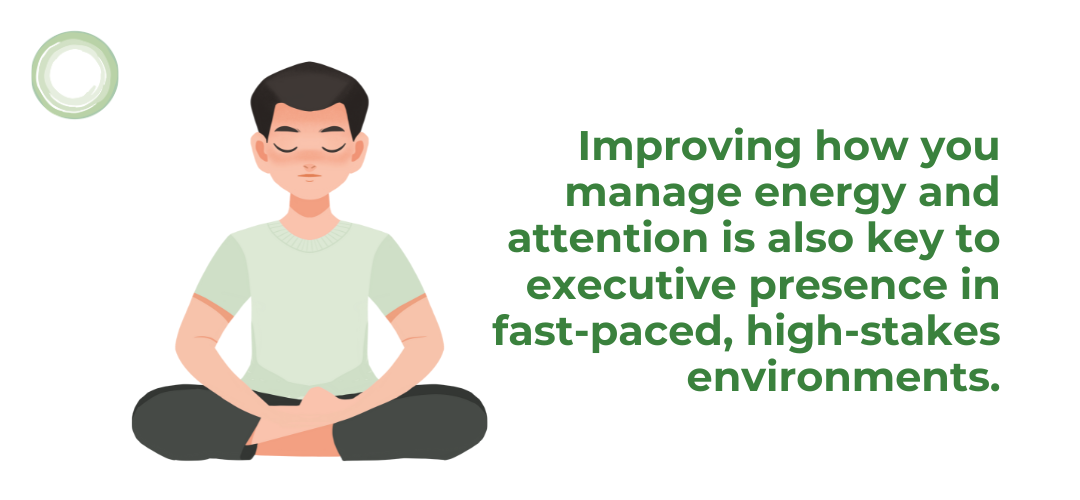Meditation in the Business World: More Than a Trend
Meditation is becoming a buzzy topic in corporate circles, and if you’ve been meaning to try the practice yourself, you must check out my brilliant friend, Emily Fletcher’s website.
But if you’re convinced that you’d never be able to meditate, don’t have the time to do it, or aren’t sure what the point is (yes, I do encounter C-level execs who roll their eyes at the mere mention of mantras), read on!
Curious how your stress style affects your leadership? Take our free Enneagram quiz to identify your focus and productivity blocks.
Perhaps you’ve missed the Forbes-vetted case studies that laud meditation as transformative for teams and leaders. Or the Harvard Business Review articles stating that executives who meditate are more focused, less stressed, and better at making sound decisions than those powered by coffee alone.
If you’ve seen all the evidence and still scoff, let me tell you how I’ve experienced the game-changing, focus-honing, stress-demolishing benefits of meditation for myself — in ways that didn’t involve inhaling incense, going vegan, or doing a silent retreat. In fact, meditation is so important to leadership effectiveness that I’ve written an entire post about it, in the hopes that you, too, benefit from the shift.
My Meditation Journey as a Leader
I turned to meditation in sheer desperation. I wasn’t drawn to it naturally; I was just TIRED. Tired of feeling unable to turn my brain off at night, tired of losing focus mid-day, tired of feeling endlessly exhausted and overwhelmed with all the travel I do. But even as a last resort, I was hesitant to try meditation because I felt sure I’d “fail” at it. Like many people, I believed that successful meditation was an activity reserved for the superhuman few who could clear their minds of everything.
But after a bit of exploration and research, I discovered that there’s more than one way to meditate, and embraced techniques that didn’t require me to turn off my thoughts like a light. Vedic meditation—the style that I now practice— embraces a steady stream of thoughts as part of life.
Want to integrate meditation into your leadership style? Our leadership coaching programs help you and your team sustain energy and clarity.
Why You Don’t Need an Empty Mind to Meditate
When I sit down for a 20-minute session, I choose a mantra as a point of focus. I allow my mind to alternate between the mantra and whatever thoughts naturally flow in. I don’t even attempt to quiet or focus my thoughts, I just let them wash over me in measured intervals, pulsing in and out between the mantras. Studies have proven that this style of meditation can lower levels of cortisol, the dreaded stress hormone, and even boost brain functioning. Two 20-minute sessions per day supercharged my creativity, enabled me to maintain laser-sharp focus for longer, and enhanced my ability to move fluidly from one task to another.
These kinds of shifts are exactly what we coach in our Enneagram Applied course — designed for leaders who want to perform at their best without burning out.
Once I realized that meditation-as-mind-emptying was a myth, it became my personal secret weapon against insomnia, endless brain chatter, and sluggish productivity. And once I saw how beneficial it was to my own business, I started nudging my clients toward incorporating meditation into their team practices.
Major Companies Are Already on Board
Some business leaders are just the teensiest bit prejudiced against ideas and activities they view as being on the woo-woo/white light/touchy-feely end of the spectrum.
Luckily, more and more corporations are recognizing the benefits of carving out company time for a little mantra-based focusing. Target, Google, General Mills, Adobe, and Ford are just a few of the heavy-hitters who’ve embraced meditation as a tool for improving employee relationships and boosting leadership productivity. The Atlantic reports that mindfulness programming at Aetna has saved the company $2,000 per employee in healthcare costs, and gained about $3,000 per employee in productivity. Hard to argue with that kind of evidence, am I right?
If you’re holding onto Meditation Myth #2 – that only hippies should sit cross-legged and focus on their breath – you might soon be in the minority.
Yes, You DO Have Time to Meditate
I’ll admit right now that I struggle to carve two 20-minute chunks out of my workday. The afternoon session is particularly challenging; Even though I know it’ll be deep, cleansing, and restorative, by 3 p.m. my to-do list looms large.
When my desire to skip a session surges, I remind myself that if I take that time to meditate the rest of my day will go smoother. I acknowledge that skipping snares me in a vicious cycle and that allowing myself the time and space to re-focus is an investment in my productivity. My post-meditation mind can often crank out a stellar report in half the time that my unfocused mind could. Blowing off a session inevitably bites me in the butt.
Sometimes I still lose the battle. A tight deadline or jam-packed schedule wins out, and skip my 20-minute brain breaks. But when I pause to meditate, I see positive effects immediately: in a restful night’s sleep that follows and the rewarding, energized next day of work. Improving how you manage energy and attention is also key to executive presence in fast-paced, high-stakes environments.
It’s not exactly a myth to believe you lack time to meditate, but it’s a short-sighted viewpoint. Make the time, and you’ll reap the rewards.

Interested in learning more about the benefits of regular meditation and how it can boost your business or team productivity?
Check out my friend and rock-star meditation teacher, Emily Fletcher’s website and classes. This training is all about banishing stress and finding a way out of overwhelm so you can perform at the top of your game.
I’m also happy to answer any questions you have, so don’t be shy! What would you like to know about meditation as a business-booster? Which meditation myths can I bust for you? Feel free to contact me to set up some time for your first consultation.


